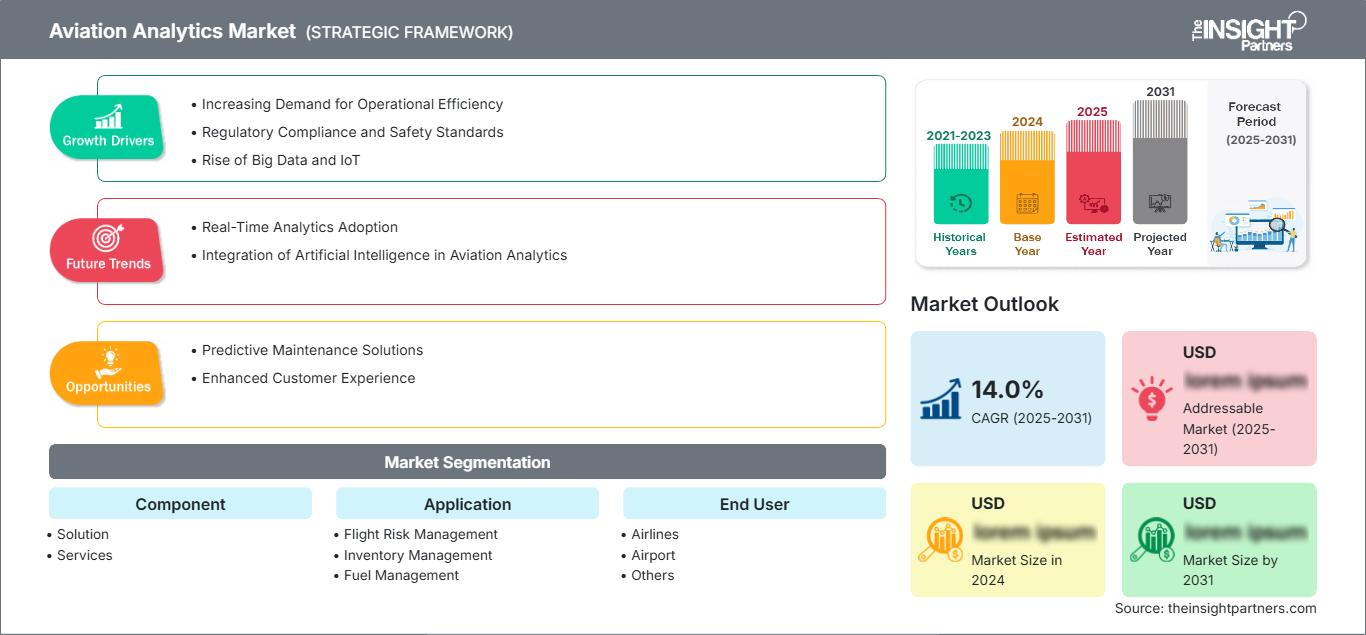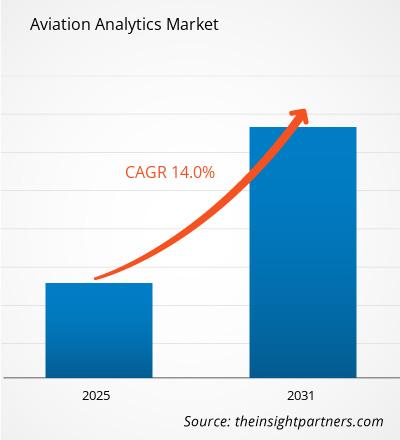Si prevede che il mercato dell'analisi dell'aviazione raggiungerà i 6,29 miliardi di dollari entro il 2031. Si prevede che il mercato registrerà un CAGR del 13,2% nel periodo 2025-2031.
Il rapporto è segmentato per componente (soluzione, servizi); applicazione (gestione del rischio di volo, gestione dell'inventario, gestione del carburante, gestione dei ricavi, analisi dei clienti, servizi di navigazione); utente finale (compagnie aeree, aeroporti, altri). L'analisi globale è ulteriormente suddivisa a livello regionale e per i principali paesi. Il rapporto offre il valore in dollari per l'analisi e i segmenti sopra indicati.
Scopo del rapporto
Il rapporto Aviation Analytics Market di The Insight Partners mira a descrivere il panorama attuale e la crescita futura, i principali fattori trainanti, le sfide e le opportunità. Ciò fornirà spunti a vari stakeholder aziendali, come:
- Fornitori/produttori di tecnologia: per comprendere le dinamiche di mercato in evoluzione e conoscere le potenziali opportunità di crescita, consentendo loro di prendere decisioni strategiche informate.
- Investitori: per condurre un'analisi completa delle tendenze in merito al tasso di crescita del mercato, alle proiezioni finanziarie del mercato e alle opportunità esistenti lungo la catena del valore.
- Organismi di regolamentazione: per regolamentare le politiche e le attività di controllo nel mercato con l'obiettivo di ridurre al minimo gli abusi, preservare la fiducia degli investitori e sostenere l'integrità e la stabilità del mercato.
Componente di segmentazione del mercato dell'analisi aeronautica
- Soluzione
- Servizi
Applicazione
- Gestione del rischio di volo
- Gestione dell'inventario
- Gestione del carburante
- Gestione delle entrate
- Analisi dei clienti
- Servizi di navigazione
Utente finale
- Compagnie aeree
- Aeroporto
- Altri
Geografia
- Nord America
- Europa
- Asia-Pacifico
- America meridionale e centrale
- Medio Oriente e Africa
Potrai personalizzare gratuitamente qualsiasi rapporto, comprese parti di questo rapporto, o analisi a livello di paese, pacchetto dati Excel, oltre a usufruire di grandi offerte e sconti per start-up e università
Mercato dell'analisi dell'aviazione: Approfondimenti strategici

-
Ottieni le principali tendenze chiave del mercato di questo rapporto.Questo campione GRATUITO includerà l'analisi dei dati, che vanno dalle tendenze di mercato alle stime e alle previsioni.
Fattori di crescita del mercato dell'analisi aeronautica
- Crescente domanda di efficienza operativa: le compagnie aeree e le compagnie di aviazione sono costantemente alla ricerca di modi per migliorare l'efficienza operativa e ridurre i costi. Il mercato dell'analisi aeronautica è guidato dalla necessità di informazioni basate sui dati in grado di ottimizzare le operazioni di volo, i programmi di manutenzione e la gestione dell'equipaggio. Sfruttando gli strumenti di analisi, le organizzazioni possono analizzare dati storici e informazioni in tempo reale per identificare inefficienze, semplificare i processi e migliorare le prestazioni complessive. Questa attenzione all'efficienza aiuta le aziende a migliorare la redditività e la competitività in un settore difficile.
- Conformità normativa e standard di sicurezza: il settore dell'aviazione è soggetto a rigorosi requisiti normativi e standard di sicurezza. L'analisi svolge un ruolo cruciale nel garantire la conformità fornendo informazioni sulle prestazioni operative, sulla gestione del rischio e sulle metriche di sicurezza. Utilizzando l'analisi aeronautica, le aziende possono monitorare il rispetto delle normative, identificare potenziali problemi di sicurezza e implementare misure correttive. La crescente enfasi sulla sicurezza e sulla conformità spinge l'adozione di soluzioni di analisi, poiché le organizzazioni si impegnano a mantenere standard elevati riducendo al minimo i rischi operativi.
- Ascesa dei Big Data e dell'IoT: la proliferazione dei Big Data e dell'Internet of Things (IoT) nel settore dell'aviazione è un fattore determinante per il mercato dell'analisi dei dati aeronautici. Compagnie aeree, aeroporti e aziende di manutenzione generano enormi quantità di dati da diverse fonti, tra cui informazioni sui passeggeri, sensori degli aeromobili e sistemi operativi. Le soluzioni di analisi consentono agli stakeholder di elaborare e analizzare questi dati, ricavandone preziose informazioni per il processo decisionale. La capacità di sfruttare i Big Data e le tecnologie IoT migliora la manutenzione predittiva, l'ottimizzazione dei percorsi e l'esperienza del cliente, alimentando la domanda di analisi avanzate nel settore dell'aviazione.
Trend futuri del mercato dell'analisi dei dati aeronautici
- Adozione dell'analisi in tempo reale: una tendenza importante nel mercato dell'analisi dei dati aeronautici è la crescente adozione dell'analisi in tempo reale. Con l'avvento di tecnologie avanzate di elaborazione dei dati, gli stakeholder del settore aeronautico sono ora in grado di accedere e analizzare i dati in tempo reale. Questa capacità consente di ottenere informazioni immediate sulle prestazioni operative, sul flusso di passeggeri e sulle esigenze di manutenzione. L'analisi in tempo reale migliora il processo decisionale e consente risposte proattive a problematiche emergenti, migliorando l'efficienza complessiva e la sicurezza nelle operazioni di trasporto aereo. Con il continuo progresso tecnologico, si prevede che l'utilizzo dell'analisi dei dati in tempo reale diventerà una pratica standard nel settore.
- Integrazione dell'intelligenza artificiale nell'analisi dei dati per l'aviazione: l'integrazione dell'intelligenza artificiale (IA) nell'analisi dei dati per l'aviazione è una tendenza emergente che sta rimodellando il mercato. Le tecnologie di IA, come l'apprendimento automatico e l'elaborazione del linguaggio naturale, possono analizzare grandi set di dati per identificare modelli e prevedere i risultati in modo più accurato. Questa integrazione consente alle compagnie aeree di ottimizzare le strategie di prezzo, migliorare la pianificazione delle rotte e migliorare il processo decisionale operativo. Con la continua evoluzione delle capacità di IA, il mercato dell'analisi dei dati per l'aviazione sfrutterà sempre di più queste tecnologie per guidare l'innovazione e migliorare le prestazioni in vari aspetti delle operazioni di trasporto aereo.
Opportunità di mercato nell'analisi dei dati per l'aviazione
- Soluzioni di manutenzione predittiva: una delle principali opportunità nel mercato dell'analisi dei dati per l'aviazione risiede nello sviluppo di soluzioni di manutenzione predittiva. Analizzando i dati provenienti dai sistemi e dai sensori degli aeromobili, l'analisi può aiutare a prevedere potenziali guasti e necessità di manutenzione prima che si verifichino. Questo approccio proattivo riduce i tempi di fermo, aumenta la disponibilità degli aeromobili e migliora la sicurezza. Poiché le compagnie aeree cercano di ridurre al minimo i costi di manutenzione e migliorare l'affidabilità operativa, cresce la domanda di soluzioni di analisi predittiva in grado di ottimizzare le strategie di manutenzione e prolungare la durata di vita degli aeromobili.
- Miglioramento dell'esperienza del cliente: l'analisi del settore aeronautico offre un'importante opportunità per migliorare l'esperienza complessiva del cliente. Analizzando i dati dei passeggeri, le compagnie aeree possono ottenere informazioni su preferenze, comportamenti e punti critici. Queste informazioni possono essere utilizzate per personalizzare i servizi, ottimizzare le strategie di prezzo e migliorare le interazioni con i clienti. Inoltre, l'analisi può contribuire a semplificare processi come l'imbarco e la gestione dei bagagli, riducendo i tempi di attesa e migliorando l'esperienza di viaggio complessiva. Poiché le compagnie aeree danno priorità alla soddisfazione del cliente, si prevede che la domanda di soluzioni basate sull'analisi per migliorare la qualità del servizio aumenterà.
Mercato dell'analisi aeronautica
Le tendenze regionali e i fattori che influenzano il mercato dell'analisi aeronautica durante il periodo di previsione sono stati ampiamente spiegati dagli analisti di The Insight Partners. Questa sezione illustra anche i segmenti di mercato e la geografia della gestione delle malattie del ritmo cardiaco in Nord America, Europa, Asia-Pacifico, Medio Oriente e Africa, America meridionale e centrale.
Ambito del rapporto di mercato sull'analisi dell'aviazione
| Attributo del rapporto | Dettagli |
|---|---|
| Dimensioni del mercato in 2024 | US$ XX Billion |
| Dimensioni del mercato per 2031 | US$ 6.29 Billion |
| CAGR globale (2025 - 2031) | 13.2% |
| Dati storici | 2021-2023 |
| Periodo di previsione | 2025-2031 |
| Segmenti coperti |
By Componente
|
| Regioni e paesi coperti |
Nord America
|
| Leader di mercato e profili aziendali chiave |
|
Densità degli operatori del mercato dell'analisi aeronautica: comprendere il suo impatto sulle dinamiche aziendali
Il mercato dell'analisi dei dati aeronautici è in rapida crescita, trainato dalla crescente domanda degli utenti finali, dovuta a fattori quali l'evoluzione delle preferenze dei consumatori, i progressi tecnologici e una maggiore consapevolezza dei vantaggi del prodotto. Con l'aumento della domanda, le aziende stanno ampliando la propria offerta, innovando per soddisfare le esigenze dei consumatori e sfruttando le tendenze emergenti, alimentando ulteriormente la crescita del mercato.

- Ottieni il Mercato dell'analisi dell'aviazione Panoramica dei principali attori chiave
Punti di forza
- Copertura completa: il rapporto copre in modo completo l'analisi di prodotti, servizi, tipologie e utenti finali del mercato dell'analisi dell'aviazione, fornendo un panorama olistico.
- Analisi degli esperti: il rapporto è compilato sulla base della conoscenza approfondita di esperti e analisti del settore.
- Informazioni aggiornate: il rapporto garantisce rilevanza aziendale grazie alla sua copertura di informazioni recenti e tendenze dei dati.
- Opzioni di personalizzazione: questo rapporto può essere personalizzato per soddisfare le esigenze specifiche del cliente e adattarsi in modo appropriato alle strategie aziendali.
Il rapporto di ricerca sul mercato dell'analisi dell'aviazione può, quindi, aiutare a guidare il percorso di decodificazione e comprensione dello scenario del settore e delle prospettive di crescita. Sebbene possano esserci alcune valide preoccupazioni, i vantaggi complessivi di questo rapporto tendono a superare gli svantaggi.
- Analisi storica (2 anni), anno base, previsione (7 anni) con CAGR
- Analisi PEST e SWOT
- Valore/volume delle dimensioni del mercato - Globale, Regionale, Nazionale
- Industria e panorama competitivo
- Set di dati Excel
Report recenti
Testimonianze
Motivo dell'acquisto
- Processo decisionale informato
- Comprensione delle dinamiche di mercato
- Analisi competitiva
- Analisi dei clienti
- Previsioni di mercato
- Mitigazione del rischio
- Pianificazione strategica
- Giustificazione degli investimenti
- Identificazione dei mercati emergenti
- Miglioramento delle strategie di marketing
- Aumento dell'efficienza operativa
- Allineamento alle tendenze normative






















 Ottieni un campione gratuito per - Mercato dell'analisi dell'aviazione
Ottieni un campione gratuito per - Mercato dell'analisi dell'aviazione